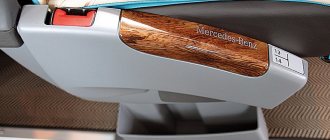The official presentation of the new generation Mercedes-Benz Vito (W447) 2014-2015 took place at the Paris Motor Show in October of this year. The start of sales of the new Vito in Russia is planned for November, and there is already official data on what configurations and prices of the new Mercedes-Benz Vito will be available here. So, let's begin our acquaintance with a popular workhorse from a well-known manufacturer.
The new Vito is the ideal assistant for solving many problems faced by individual entrepreneurs, transporters or owners of workshops on wheels. The Mercedes-Benz Vito van is the only vehicle in the segment that is offered in three lengths and the same number of drive options.
The carrying capacity of the new Mercedes Vito 2014-2015 reaches 1369 kg. There is also a cargo-passenger version with a double cabin on sale. It combines the main advantages of a minibus and a van. For transporting passengers, it is better to choose the Vito Tourer modification. There are three modifications of such minibuses - BASE, PRO and SELECT. The new Vito passenger allows you to satisfy a wide variety of requests related to the transportation of passengers.
Body options and dimensions
Compared to the second generation model, the new Mercedes Vito received a longer body in all versions (+140 mm). One of the reasons is to increase the length of the front end for better protection of pedestrians. The body length of the 3rd generation Vito can be 4895, 5140 or 5370 millimeters. The maximum height of the Mercedes-Benz Vito New is 1910 mm (+ 48 mm for roof rails). This means that any version of the car is much lower than the 2-meter mark, which will allow you not to worry about the use of underground parking lots.
The use of a new front-wheel drive system and a small diesel engine allowed engineers to reduce the weight of the Vito van in the medium length version in the initial version to 1,761 kg. The driver and passenger will definitely enjoy the comfortable seats and convenient visibility.
Multitasking and easily adaptable
Our goal is to fulfill your wishes in an ideal way. That's why we've designed Vito to be very easy to adapt to the individual needs of your business. Whether compact and manoeuvrable for urban conditions, a high roof or the longest loading area – the Vito range offers configurations that allow you to easily cope with a wide variety of transport tasks and loading conditions.
2 wheelbase options 3 vehicle length options (compact/extended/extra-long) 2 roof height options Cargo space volume up to 7.49 m³ Load capacity up to 1,000 kg, optionally increased to 1,345 kg Gross standard weight from 2.8 to 3, 2 tons Placement of up to three Euro pallets in a row, depending on the vehicle length Wide choice of engines
Salon
The instrument panel was designed from the ground up and is a harmonious combination of ergonomics and impressive functionality. The intelligent shape of the panel forms the basis for the highest operating safety of the Mercedes-Benz Vito. Such a sophisticated instrument panel is extremely rare on cars of this class.
It is noteworthy that the developers paid great attention to the issue of storing various things. But the new Vito 2014-2015 is not just a workplace for many drivers, but also a place where they literally “live”.
Engines
The manufacturer offers a couple of turbocharged diesel engines and 5 different versions, differing in power, for the new Mercedes Vito. If you plan to use the car in most cases without a trailer, counting on minimal costs, we recommend choosing a version with front-wheel drive and a transverse engine. The compact 1.6-liter “four” is available in two versions: on the 109 CDI, the engine performance is 88 hp, and under the hood of the 111 CDI modification there is a 114-horsepower version of the unit.
For those people who constantly use trailers and use the car quite intensively, we advise you to buy a new Vito 2014-2015 with rear axle drive and a 2.2-liter engine. This unit is available in three power options:
- The 114 CDI is equipped with a 136-horsepower engine;
- 116 CDI received an engine with 163 horsepower;
- 119 BlueTEC hides a 190-horsepower unit under the hood.
Particular attention should be paid to the Mercedes Vito 119 BlueTEC version, since it is equipped with an engine that meets the requirements of the Euro-6 standard.
Characteristics of Mercedes Vito / Mercedes Vito
Mercedes-Benz Vito is a cargo van, a cargo-passenger “combi”, an inexpensive (of course, by European standards) minibus on a W638-type platform.
The starting point in the fate of the Mercedes-Benz V-Class is considered to be 1995. Then, at the DaimlerChrysler plant in the city of Vitoria in northern Spain, mass production of the Vito small-class truck began, which has proven itself well as an office on wheels, a family minivan or a corporate taxi. In 1996, the Vito won the title of best van of the year. The main modifications of the family are an all-metal van with a carrying capacity of 895-925 kg and a 9-seater bus with a loading capacity of 740 kg. Vito is equipped with diesel engines with 79 and 98 hp. and gasoline engines with 129 and 143 hp.
In 1996, at the Geneva Motor Show, a high-capacity station wagon from Mercedes-Benz was first shown, based on the Vito truck and called the V-Class. For greater comfort, pneumatic elements replaced coil springs in the rear suspension, sound insulation and interior trim were improved, and the appearance was slightly changed due to hinged parts. The result is a vehicle that retains the space of a commercial van, but with a higher level of comfort. The minivan went on sale in 1997.
In 1998, the cars underwent a slight modernization - CDI diesel engines with a Common Rail fuel supply system appeared. The consumer qualities of minivans have been enhanced due to a noticeable update of the interior and internal equipment.
In 2003, DaimlerChrysler, instead of thoroughly modernizing the models to replace the old Vito and V-Class, introduces completely new cars - Vito and Viano. These two models, which the company released at the same time, look similar to each other like twin sisters, but are completely different in essence. Mercedes-Benz Vito is presented in three guises at once: a thoroughbred workhorse, a cargo-passenger van and a roomy minibus. To produce the new model, the usable area at the Spanish plant in Vitoria was almost doubled. On the new site, a new bare body assembly shop was built, housing 550 state-of-the-art industrial robots, a new paint shop and a new final assembly shop. Starting in the autumn of 2003, the new Mercedes-Benz Vito gradually began to replace light commercial vehicles.
The second generation Vito comes in three body lengths (the shortest Compact is 4748 mm; Long is 4993 mm; the longest Extralong is 5223 mm), two wheelbase sizes (3200 and 3430 mm), two roof styles (low and high, with useful volume from 4.65 to 6.49 m3, cargo compartment length 2224-3099 mm) and five engines with power from 88 to 218 hp. By the way, from 2005 there will be a medium roof option. One of the most attractive should be the so-called Panel van - a van with a useful body volume of 6.49 m3 (on its predecessor - a maximum of 4.8 m3) and a loading capacity of up to 1140 kg and a six-seater Vito Mixto for combined cargo and passenger transportation with a luggage compartment volume of 970 liters. It carries up to six people and can carry large cargo volumes, which is typically required in various industries such as construction, utilities, etc. Those who value the number of seats in the cabin may like the Vito, which is designed to carry 9 people, including the driver, while still leaving approximately one cubic meter of cargo space free to accommodate travel luggage.
A significant difference between the new generation Vito is its completely new body. The angular shapes of the previous generation have given way to smoother and more dynamic lines, which is especially noticeable in profile and frontal view; the harmonious line from the bumper to the windshield and the smooth transition to the side elements cannot be confused with anything - they clearly demonstrate the family features of Mercedes. Among the external changes, the most striking are the new radiator grille in front, the spectacular stamping on the hood and the large vertical dimensions. The appearance of the rear of the car is determined by large, vertically positioned rear lights. Whether the wheelbase is 3200 mm or 3430 mm, the Vito comes with new sliding side doors that make loading luggage into the car much easier. The van's 180° and 270° rear hinged doors, which can be ordered in place of the liftgate, allow for easy loading and unloading. The luggage compartment opening between the wheel arches is 1277 mm, and cargo can also be stowed under the front seats, which means an additional 200 mm of usable length at any wheelbase size. The maximum roof load is 150 kg.
Inside, the new design affected almost everything: the dashboard, buttons and air conditioning control levers, pockets and small compartments for various things. At the top of the dashboard there is a compartment where you can put A4 paper, folders and road maps. The volume of the glove compartment has been increased to 11 liters. The driver and front passenger seats are adjustable longitudinally; in addition, it is possible to smoothly adjust the seats in height, backrest angle and seat cushion. Such a thoughtful interior design, seats with integrated three-point seat belts, various adjustment options and much more make the Mercedes-Benz Vito a worthy means of transporting passengers, including guests of expensive hotels, or a good purchase for expanding the bus fleet. However, the car has obvious shortcomings, and not every modification of the new Vito is worthy of high ratings in comparison with its predecessor. There are complaints regarding visibility: the wide A-pillar blocks visibility when cornering, and the middle rear headrest in passenger versions almost completely deprives the driver of visibility. In sunlight, the orange symbols on the instrument panel are completely invisible and to read the information you have to extend the visor with your palm. As for other points: in the interior of previous minibuses there was an open garbage tank - and when making a sharp turn, its contents flew out onto the passengers. Now the “trash can” has been made bigger by closing it with a lid. And this threatens that children can stuff apple cores and banana skins into it, and the driver will not know about it until it all starts to rot! And yet there are many more positive aspects. This includes a decent level of comfort for passenger modifications, a powerful ventilation system, and excellent ergonomics.
The design of the new Vito has essentially nothing in common with its predecessors. Structurally, the new Vito is completely different from the front bumper to the exhaust pipe (although their purpose has not changed). And their main difference is in the layout. If the previous Vito and V-Class were front-wheel drive, with a transversely mounted power unit, now the engine and gearbox are located longitudinally, and the drive is rear-wheel drive. This transformation from a front-wheel drive car to a “classic” was influenced by at least two problems. The first is that previous models suffered from vibrations in the steering wheel, and the classic layout made it possible to get rid of them. The second is passive safety. If the previous Vito is crash tested according to modern EuroNCAP rules, its engine will go into the cabin - with all the ensuing consequences. And the power unit, located longitudinally, “dives” under the floor upon impact, without causing harm to riders. In addition, front-wheel drive vehicles had clearly underloaded rear wheels (this was especially noticeable on vans). Since rear-wheel drive entails a more pronounced tendency to skid, the developers have equipped the cars with a number of standard electronic safety systems: this is the ESP automatic vehicle dynamics control system, including the ABS anti-lock braking system, the ASR traction control system, an electronic brake force distribution system and a hydraulic emergency braking system. . Three-point seat belts on all seats and belt tensioners on the driver and front passenger seats are included as standard. A full-volume airbag for the driver is installed in all versions, and for the front passenger - in the station wagon version. In addition, dual airbags and window airbags can be installed on the front passenger side if desired. Along with the optional luxury seats, new side thorax airbags are also available. The car's reaction when colliding with an obstacle has been significantly improved: its strength and rigidity have increased, and the characteristics of bending, warping and twisting have been improved for all versions. In the front part there are deformable zones that, in the event of a collision, absorb the maximum part of the kinetic energy, and in minor accidents, prevent damage to the longitudinal beams of the frame. In addition, the safety of the vehicle is also ensured by standard luggage loops, a system of guides for securing luggage in the cargo compartment of vans, as well as various devices that prevent cargo from shifting and dividing partitions.
The new Vito can also solve a variety of transport tasks with the help of a wide range of engines. There are five Euro 4 compliant engines to choose from: second-generation in-line four-cylinder CDI diesel engines with 88, 109 and 150 hp, and V6 petrol engines with 190 and 218 hp. with Bosch Motronic ME 2.8 injection system. Each version has its own torque characteristics, the peak of which is stretched in the power range from 65 kW to 160 kW rpm. This increase in power is especially noticeable in the lower rev range, resulting in increased engine response and driving pleasure. The maximum torque of the three diesel engines is 220 Nm, 270 Nm and 330 Nm respectively and remains constant over a wide speed range. As standard, the Vito received a 6-speed manual transmission; V6 gasoline engines are equipped as standard with a five-speed automatic transmission, which can optionally be installed with diesel units. Engines have become much more dynamic, quieter, more economical, and, which is especially important lately, more environmentally friendly. Improvements in the transmission ensure a comfortable ride and allow the car to behave confidently on the road. By the way, the gearbox itself is made in the latest fashion - six-speed, with a “joystick” instead of a long lever, and the reverse gear is equipped with “foolproof protection” (to turn it on, you first need to lift the ring on the lever).
The Vito is equipped with independent suspension on all wheels. The front axle is equipped with MacPherson shock absorbers, on which the anti-roll bar mounts are located. The rear axle suspension uses coil springs separated from shock absorbers.
The new Vito comes with 300 mm disc brakes at the front and 296 mm at the rear. The front discs are ventilated, the rear discs are solid. The standard equipment includes a brake force regulator and a hydraulic emergency braking system Brake Assist - thanks to this you can feel confident behind the wheel on any road. The car is offered with 16-inch wheels, and alloy wheels can be ordered upon request. The basic equipment of all versions includes central locking, electric windows, adjustable steering wheel, electric drive and heated side mirrors and a CD player.
Mercedes-Benz commercial light-duty vehicles are produced at several company plants both in Europe and abroad.
Transmission
The basic version of the new Vito 2014-2015 model year with rear-wheel drive is equipped with a 6-speed manual transmission. A 7-speed automatic transmission is available as an option for the Vito 114 CDI and 116 CDI versions. In addition, this transmission is available in the Vito 119 BlueTEC and the new generation all-wheel drive Vito. In fact, this is a unique example of the use of a 7-band torque converter automatic transmission in light-duty vehicles.
Drive options
Mercedes Vito is new and in drive version. The car became the first representative of its class in which the manufacturer offers not only all-wheel or rear-wheel drive, but also front-wheel drive.
This solution is very easy to understand: the new version of the Mercedes-Benz Vito with front axle drive has the lowest weight in the range. With minimal or no load, front-wheel drive provides additional traction benefits. You can also mention its affordable price.
The rear-wheel drive Mercedes Vito also performed excellently. Such a car will be an excellent choice for solving various tasks associated with heavy loads or towing heavy trailers. It is also suitable for those who need maximum dynamics.
All-wheel drive is often chosen by those users who have to partly operate the car in difficult weather conditions. The all-wheel drive Vito 2014 will also help in those places where there are no roads with good surfaces. The use of a modern design of the all-wheel drive mechanism made it possible to maintain the same height of the car as on single-wheel drive versions.
Fuel consumption
The low fuel consumption of the new Mercedes Vito is another feature of the model. Specialists from Germany tried to optimize the operation of the transmission, rear axle, electromechanical control and additional components in order to achieve maximum fuel economy. According to official data, the average diesel consumption of the Mercedes-Benz Vito has decreased by 20% compared to the previous generation of the car.
The most economical version is the Vito BlueEfficiency version. This kit is offered only for the rear-wheel drive Vito, and it is already presented in the initial configuration of the Vito Tourer versions with automatic transmission, in versions that are designed for use as passenger cars, and also in tandem with the most powerful power unit. The fuel consumption of the new Vito in this version is 5.7 liters per 100 kilometers (version 116 CDI BlueEfficiency).
New look of a universal car
Success does not come just like that: it is achieved through hard everyday work. And the new Vito will be an even more effective help for you in this matter. Its 4-cylinder CDI diesel engines of a completely new generation and the optional BlueEFFICIENCY package set new standards in terms of efficiency and environmentally friendly development of automotive technology. A newly developed suspension, an even more luxurious interior and a host of new equipment will ensure that you can concentrate even better on what matters most – your work.
Safety
The new generation Mercedes Vito is a unique car in the light-duty segment for the reason that even the van version has airbags and seat belt sensors in its base. The Vito Tourer SELECT and Vito Tourer PRO modifications also received window Airbags, which provide reliable protection for the hip area and chest of the driver and front passenger.
It is noteworthy that for the first time, the new Vito (Vito Tourer version) has window airbags located in the rear of the car. Top trim levels of the Mercedes Vito include 8 airbags, which is an exclusive offer in the class.
It is also worth noting that the initial equipment of the new Mercedes Vito includes a system that monitors the level of driver fatigue. The base is also equipped with a crosswind stabilization system. It can easily compensate for the effect of wind gusts on the car body. The initial configurations of the new generation Vito also include a tire pressure monitoring system.
The new Vito is available with a large number of optional systems. For example, buyers have access to an auxiliary system that makes it easier to park a car. In addition, it is worth noting the presence of technology for informing about unsafe distances. The driver will also be helped by a blind spot monitoring system, which will promptly inform about the presence of other vehicles in such a zone. The system that keeps the car in the selected lane also contributes to safety.
Typical faults
During production, the car was twice called for service campaigns. The first was in 1998 due to problems with Continental and Semperit tires. The second - in 2000 to eliminate problems with the brake booster.
Vito's weakest point is corrosion. It's all about poor body protection. Rust appears literally everywhere. The first outbreaks, as a rule, appear on the lower corners of the doors, hood, and rear trunk door. Before you settle on a specific instance, you should take a closer look at the thresholds, floor and, if possible, look under the door seal.
If there are no traces of rust on the body, then it has probably been repaired. In most cases, this work is done hastily just to make the car look nice at the time of sale. Be on the lookout!
There are also electrical problems. In diesel versions, the glow plug relay is acting up. The starter, alternator, radiator fan, power windows and central locking often fail. The thermostat is another part that will soon need to be replaced. From time to time the air conditioning system and heater “show character”.
Before purchasing, be sure to check the operation of the side sliding doors, which jam if the guides are damaged. Owners complain about the very low quality of the interior plastic - it makes unpleasant sounds while driving.
Sometimes gearbox cables and universal joints fail. The 4-speed automatic transmission does not cause problems, provided that the operating recommendations for changing the oil are followed. The Vito's steering mechanism is not very durable - play appears quite quickly.











